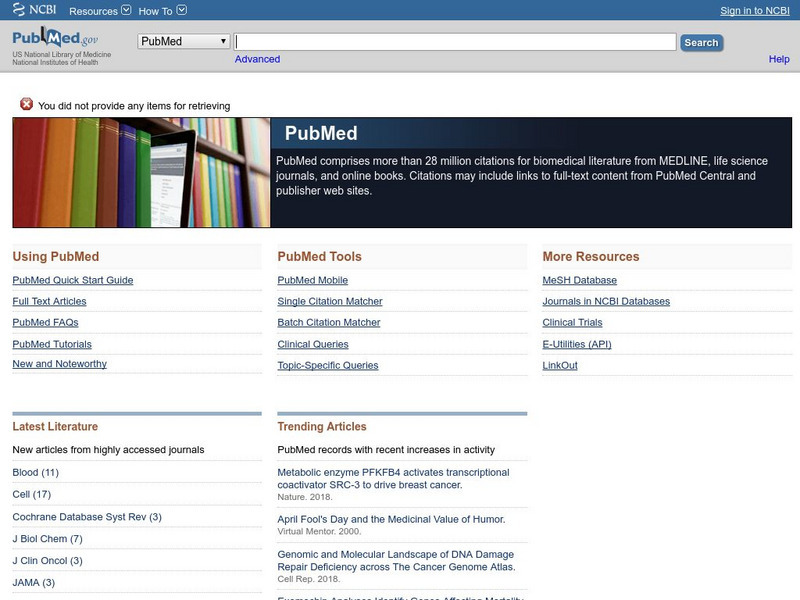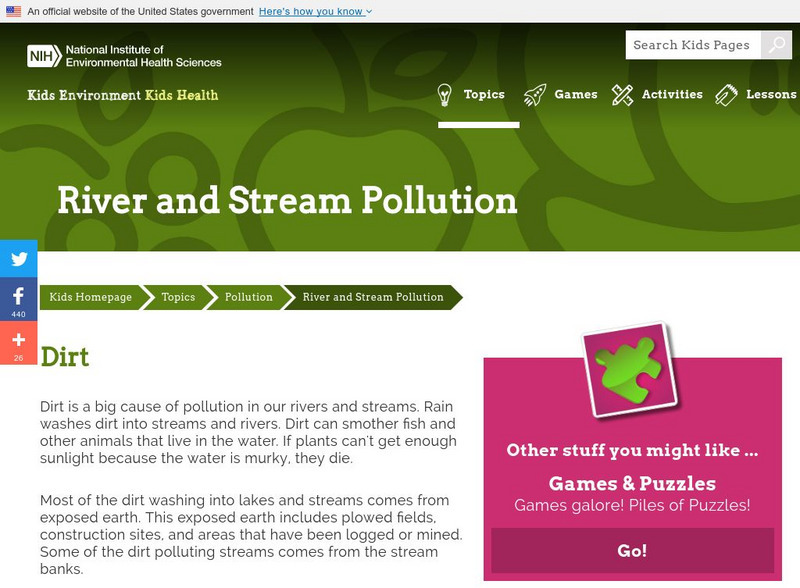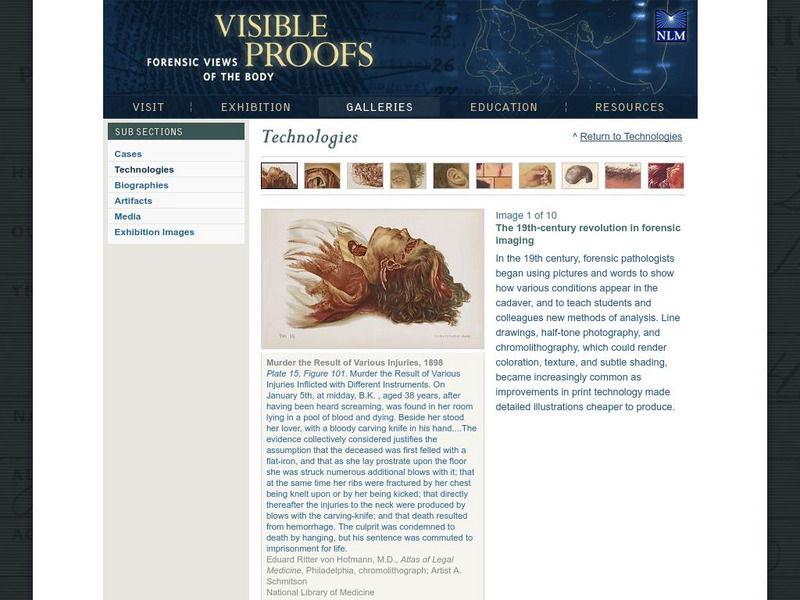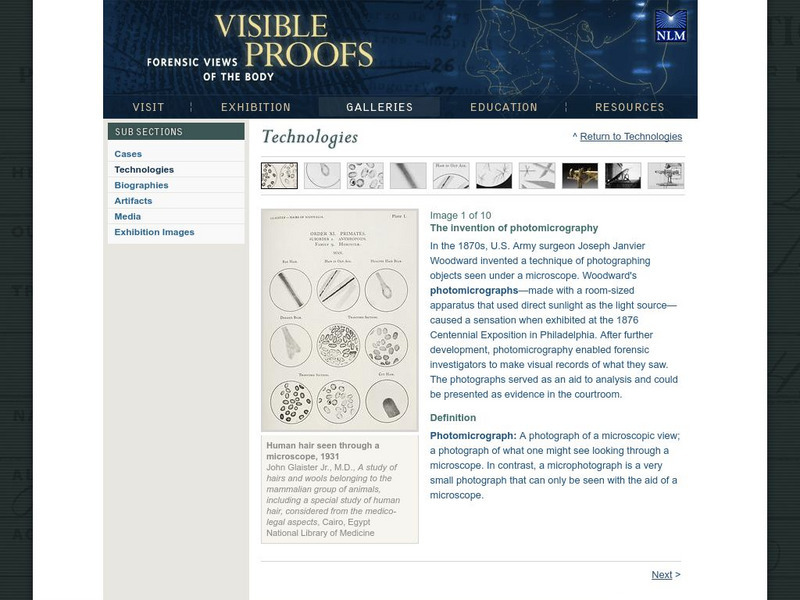National Institutes of Health
National Institutes of Health: What Are Embryonic Stem Cells?
What stages of early embryonic development are important for generating embryonic stem cells? How are embryonic stem cells grown in the laboratory? What laboratory tests are used to identify embryonic stem cells? Article addresses these...
National Institutes of Health
National Institutes of Health: Potential Uses of Human Stem Cells
Stem cell therapy holds a great deal of promise, but years of intensive research are needed to develop their full potential. This informative site looks at the possibilities and challenges related to the potential uses of stem cells.
National Institutes of Health
Ncbi: Trisomy 15 Loss of Y Chromosome in Bone Marrow
This brief article summarizes possible relationship between the development of trisomy 15 in the bone marrow cells of elderly patients with a hemotological malignancy.
National Institutes of Health
Ncbi: Pub Med: Management of Herpes Zoster (Shingles) and Postherpetic Neuralgia
This is an abstract of an article about the various treatments used for herpes zoster (shingles) and associated postherpetic neuralgia. The treatment options are listed.
National Institutes of Health
Pub Med: Men, Women, and Murder: Gender Specific Differences
This is an abstract of an article published in 1992 that examined crime data for 1976-1987. It looked at the differences between men and women in the roles of victim or offender in homicide cases.
National Institutes of Health
Niehs: Kids' Pages: River and Stream Pollution
What makes our rivers and streams dirty? This brief overview discusses the causes of pollution in rivers and streams and how to solve it.
National Institutes of Health
Snack Smart for Healthy Teeth
Learn how to avoid tooth decay by avoiding sugary snacks and treats. Try a snack from the "smart snack food list" and reduce the amount of sugar you eat on a daily basis.
National Institutes of Health
National Institute of Health: Tuberculosis
The National Institute of Health gives the basics about the disease tuberculosis.
National Institutes of Health
National Institutes of Health: Aim for a Healthy Weight
This page links you to recommendations, risk assessments, and suggestions for controlling weight. Most useful is the link to publications for more in-depth info.
National Institutes of Health
National Library of Medicine: Reading Gunshot Patterns
Various pictures of parts of the human anatomy showing gun shot trauma are found on this interesting site. .
National Institutes of Health
National Library of Medicine: The Bertillon System
Bertillon devised a system to make order out of the myriad of crime scene photos taken by the police. This brief site describes how that system worked and shows a number of crime scene photos taken from Bertillon's photo album.
National Institutes of Health
National Library of Medicine: Key Accomplishments, Dna
A brief history of the major discoveries related to DNA from 1865 until 1991. Pictures of the responsible reponsibile for these key accomplishments are included as well.
National Institutes of Health
National Library of Medicine: The 19th Century Revolution in Forensic Imaging
In the 19th century, forensic pathologists began to use words and pictures to describe cadavers and to teach using cadavers in the classroom. See a number of interesting photos of various crime scenes on this interesting site.
National Institutes of Health
National Library of Medicine: The Marsh Test
The Marsh Test, developed in 1832, was designed to detect poison in drinks. A short history of this test is provided along with photo of the test apparatus.
National Institutes of Health
National Library of Medicine: The Invention of Photomicrography
The technique of photographing objects observed under a microscope is discussed in this succinct site. Various pictures taken under a microscope are displayed on this site as well.
National Institutes of Health
National Library of Medicine: Key Accomplishments, Radiology
A history of radiology is featured from 1901 until 2003. Succinct paragraphs cover the highlights of each discvery.
National Institutes of Health
National Library of Medicine: Spectral Detection
This concise site provides a brief discussion of the invention of the first work spectroscopes and their impact on forensic science.
National Institutes of Health
National Library of Medicine: Key Accomplishments, Toxicology
The history of toxicology is discussed from 1702 through 1966. Explanations of major discoveries are brief and to the point.
National Institutes of Health
National Library of Medicine: Virtopsy, the Virtual Autopsy
An interesting site that delves into how forensic scientists perform minimally invasive autopsies using state of the art technology.
National Institutes of Health
National Library of Medicine: Entomology in Action
Two lesson plans are found in this site. Lesson Plan 1 is geared to grades 6-9. In this plan, student's will be able to list the different stages of the blow fly's life cycle and understand how the life cycle and ADH (accumulated degree...
National Institutes of Health
National Library of Medicine: Dna a Molecular Identity
In this lesson plan site, students learn about DNA and examine three different situations where DNA was used to solve a case.
National Institutes of Health
Nih: Aim for a Health Weight
This brief but informative site discusses the role of body mass index and waist circumference in determining your risk of disease and death.
National Institutes of Health
Buffalo Gals
Music and lyrics to the song, "Buffalo Gals." Also includes links to a science website about moons in the parts of the lyrics that read "moon."
National Institutes of Health
Complementary & Alternative Medicine News and Events
The news & events supplicd by the national Center for Complementary & Alternative Medicine covers a broad rand of healing philosophies, approaches, and therapies not commonly used by traditional Western medicine.























